Abstract
This study presents the magnetized hybrid nanofluid flow with heat source/sink over an exponentially stretching/shrinking sheet. Slip conditions are implemented to analyze the hybrid nanofluid flow for both slip and no-slip conditions. Additionally, the hybrid nanofluid of alumina and copper (hybrid nanoparticles) with blood (base fluid) has been considered and discussed with both suction and injection parameters. The appropriate similarity variables are used to convert partial differential equations (PDEs) into ordinary differential equations (ODEs) and solved analytically with the help of the homotopy analysis method (HAM). The impact of different embedded parameters has been shown in the form of graphs and tables. The numerical values of skin friction and Nusselt number are presented in the form of Tables for both slip and no-slip cases. It is summarized that the upsurge of the velocity slip parameter and magnetic parameter increases the skin friction, while the rising of the thermal slip parameter and heat generation parameter decreases the Nusselt number.
1. Introduction
In order to achieve considerable cost and energy reductions, heat transfer intensification is essential. Currently, the advancement in science and technology is encouraging the mandate for extraordinarily featured compact devices with the greatest performance, precise working, and extensive lifetime. As a result, scholars and scientists gathered to work on heat and mass transmission analysis. The investigators were persuaded by the superior thermal transport characteristics of solids compared to ordinary fluids to create a new class of fluids, which they so-called “nanofluids”. The idea of dispersing high-thermal conductivity solid particles of micro-size into the conventional fluid was first pioneered by Maxwell [1] and then continued by Hamilton and Crosser [2] to intensify the fluid thermal conductivity. Nevertheless, some limitations and flaws still occurred, such as the coagulation in the fluid flow passage. Due to that limitation, a rapid investigation is being made, and nanofluid is established. Choi and Eastman [3] invented this novel heat transfer fluid by dispersing the nanometer-sized solid particles into the base fluid, and it is believed these could overcome the coagulation of the flow passage due to its unique feature.
However, along with the development of technologies, another new class of heat transfer fluid named hybrid nanofluid has been established. It is an extension of the nanofluid invented by the dispersion of dual or multiple kinds of nanosized (size less than 100 nm) solid particles with an excellent thermal conductivity into a base fluid. Jana et al. [4] study to improve the thermal conductivity of the fluid by evaluating the single and hybrid nano additives. Surprisingly, as associated with the single nanofluid, the hybrid nanofluid and did not enhance the thermal conductivity. Two years later, Jha et al. [5] followed with similar research. They used a combination of silver and multiwall carbon nanotubes to investigate the thermal conductivity. They have dramatically increased the thermal conductivity compared to the single nanofluids. Recently, many researchers have been interested in studying thermal conductivity and heat transfer of the hybrid nanofluids, such as Waini et al. [6,7,8,9,10].
There are numerous parameters that significantly contributed to the heat transfer improvement of the hybrid nanofluids, for example, base fluid collection, size and shape of the nanoparticles, viscidness, temperature of the fluid, steadiness, dispersibility of the nanoparticles, virtue of the nanoparticles, preparation technique, and consistency of the nanoparticles that lead to the concordant combination of the nanofluid, which can be seen in [11,12,13,14,15]. Hybrid nanofluid is claimed to have a preferable capability concerning thermal conductivity and heat transfer due to its synergistic effects, contrasted to mono-nanofluid and regular fluid. Thermal conductivity is one of the essential parameters that contribute hugely to heat transfer improvement. Different researchers exposed the importance of thermal conductivity utilizing nanofluid [16,17,18,19,20,21,22,23,24]. Recently, many researchers investigated motivating results about hybrid nanofluids, concentrating on alumina and copper as the hybrid nanoparticles, with different arrangements of the parameters have moreover been exposed by Yashkun et al. [25], Lund et al. [26,27], Aladdin et al. [28], Rosca et al. [29], Khashi’ie et al. [30,31,32,33], Roy and Pop [34], Zainal et al. [35], Anuar et al. [36], Gangadhar et al. [37] and Wahid et al. [38].
Magnetohydrodynamics (MHD) has an essential role in studying the heat transfer of hybrid nanofluid flows. It has several applications, such as the blending process of metals in the boiler. Khadija et al. [39] investigate the impact of MHD together with buoyancy force on Carreau fluid flow. Rajesh et al. [40] studied the heat transfer analysis of the hybrid nanofluid flow with MHD. Othman et al. [41] developed a mathematical model and used an exponentially shrinking sheet to study the MHD flow of the hybrid nanofluid.
Therefore, in the present study, we intended to scrutinize the slip flow and heat transfer of the hybrid nanofluid flow of alumina and copper (hybrid nanoparticles) with blood (base fluid) and heat source/sink over an exponentially stretching/shrinking sheet in the presence of suction and injection parameters. By studying the above literature review, we found that scholars and scientists have not been investigated the present hybrid nanofluid model with such configuration impact. The numerical values of Nusselt number, skin friction and the influence of various parameters are presented in graphs and discussed in detail. The analytical method (HAM) is used to solve the transformed ODEs.
2. Mathematical Formulation
Heat transfer of the hybrid nanofluid flow with heat source/sink over an exponentially stretching/shrinking sheet in the existence of suction and injection parameters is examined. The physical model of the problem is shown in Figure 1, in which the element of the velocity is in the direction and is in the directions.
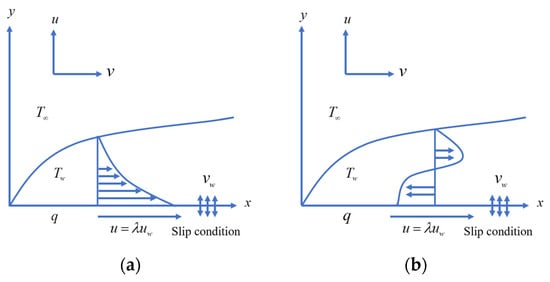
Figure 1.
Physical model of the stated problem: (a) stretching surface (); (b) shrinking surface ().
The surface velocity of the fluid is assumed as , and the mass transfer velocity of the wall is stated as . If , then it represents the mass suction, and represents the mass injection, is the stretching constant, is the shrinking constant, refers to a motionless sheet, represents temperature, is fluctuating temperature of the sheet with constant and is constant of the heat generation rate.
Therefore, concerning the mentioned boundary layer presumptions, equations of continuity, momentum and energy are formulated as below [42].
Using the boundary conditions in [43].
where and are the slip factors for velocity and thermal energy, respectively. The correlation of the physical properties (Tayebi et al. [44], Takabi et al. [45]) and the hybrid nanofluid’s thermo-physical properties (Oztop et al. [46]) is depicted in Table 1 and Table 2, respectively. Here, the represents the hybrid nanofluid, refers to the base fluid, denotes the solid nanoparticle of the alumina and refers to the solid nanoparticle of the copper. Additionally, and symbolize the alumina and copper volume fraction parameters, respectively.

Table 1.
Hybrid nanofluid physical properties.

Table 2.
Thermophysical properties.
As to reduce the above-mentioned governing Equations (2)–(4), the following similarity variables are used (Waini et al. [47]).
These accordingly fulfill Equation (1) and transform Equations (2) and (3) into the succeeding equations.
Due to the transmuted boundary conditions,
such that represents the Prandtl number, depicts the heat generation parameter, shows the velocity slip parameter, denotes the thermal slip parameter, and refers to the mass transfer parameter of the wall, in which is associated with mass suction and is associated with mass injection.
The main physical quantities of attention (local skin friction coefficient and the local Nusselt number ) are mathematically calculated as in [47].
by presenting the transformation, we have the following equations,
where represents the local Reynolds number.
3. Solution of the Problem Using HAM
To solve the above-mentioned Equations (6) and (7) using the boundary conditions shown in Equation (8), we utilized the HAM technique in the following way [48,49].
The initial guesses are chosen as below:
The linear operators are chosen as below:
which shows the succeeding characteristics.
Here, in a general solution, are constants.
The subsequent non-linear operators as follows:
The 0th-order problems from Equations (6) and (7) are:
The equivalent boundary constraints are:
Here the implanting parameters for are used to control the convergence of the solution. By putting , we have:
Expanding using Taylor’s series about .
where
The secondary parameters are taken for the purpose that the Series (20) converges at , and by putting in Equation (20), we obtain the following:
The -order deformation problem as follows:
The consistent boundary constraints are given below:
Here,
where
4. Results and Discussion
Solutions of the Equations (6) and (7) with the boundary conditions shown in Equation (8) are analytically computed using the HAM method in Mathematica software. The appropriate initial guess, boundary conditions and different values of parameters need to be chosen and well-adjusted in the coding of the HAM method to calculate the foremost exact outcomes. We considered the stretching () and shrinking () sheets. The Prandtl number for alumina is fixed in the present study, which is , while the other parameters, such as velocity and thermal slips, heat generation and suction , are set to be vary with the purpose to study their influence on the fluid flow and heat transmission.
For validation, we compared our result with the numerical method (the Shooting method). We find that the current and the numerical results are rationally interrelated. We thus guarantee that the methodology and the results of this study are valid.
Figure 2 shows the variations in the skin friction , and it is noticed that skin friction has a decreasing trend as the velocity slip parameter and magnetic parameter escalate.
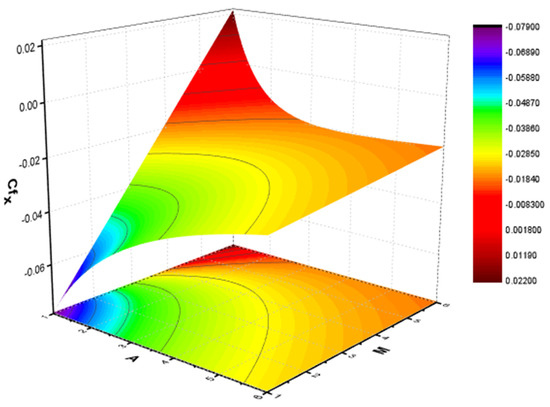
Figure 2.
Plot of skin friction for variation in and .
Figure 3 shows the variations in the local Nusselt number , and it is noticed that the enhancement in the value of and promotes the increment in the Nusselt number .
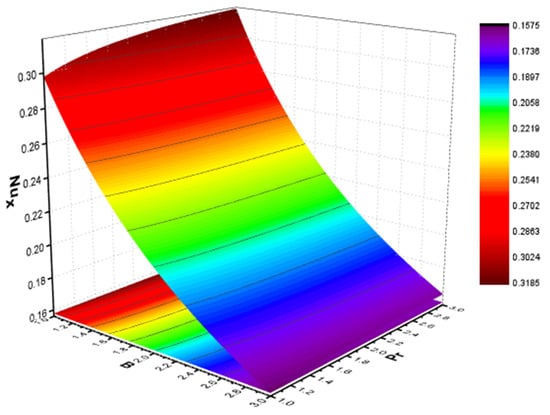
Figure 3.
Plot of Nusselt number for variation in and .
Figure 4 and Figure 5 show the impact of the velocity slip parameter on and temperature profiles , respectively. It shows that the slip parameter has an important impact on velocity and temperature distributions. This illustrates that by increasing the values of the velocity slip parameter , there is a gradual decline in the field of velocity and temperature profiles.

Figure 4.
Variations in for various values of .

Figure 5.
Variations in temperature gradient for various values of .
Figure 6 illustrates the influence of the magnetic parameter on the velocity field . It is revealed that the velocity of the fluid declined due to enhancement in magnetic parameters. The reality behind this is the application of a crosswise magnetic field, which leads to that of a drag force comparable to that of Lorentz, which shows up a resistance in the fluid flow, and as a result, it reduces the velocity of the fluid.
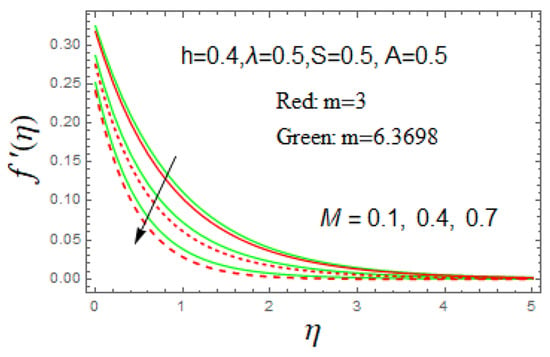
Figure 6.
Variations in for different values of .
Figure 7 and Figure 8 show the impact of on and , respectively. It is noted that when rises, the fluid velocity and temperature slow down. A comparison of the results shown in Figure 6 clearly indicates that the effect of the slip parameter on velocity and temperature is quite similar to the effect of the magnetic parameter. Therefore, it is clear from the above-mentioned example that the combination of partial slip, magnetic effect and mass transfer has a great influence on the fluid flow and temperature.
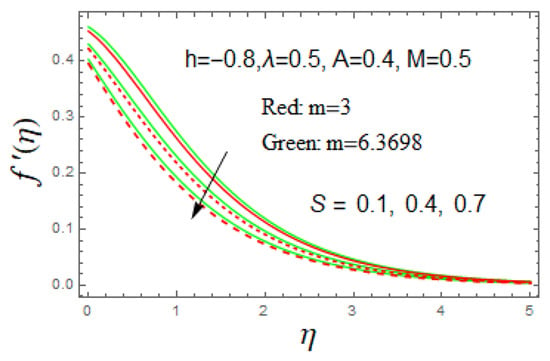
Figure 7.
Variations in velocity profile for different values of .
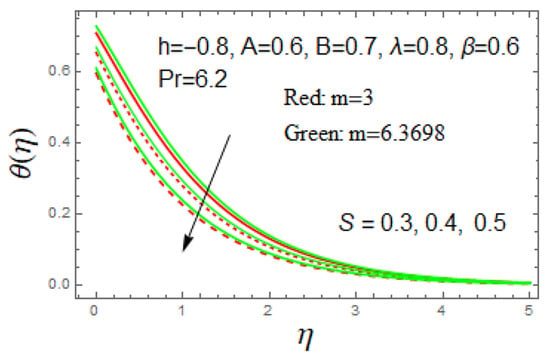
Figure 8.
Variations in temperature profile for different values of .
In Figure 9 and Figure 10, the influences of the thermal slip parameter and heat generation parameter over the temperature profile are portrayed. Since these parameters do not affect the velocity profile , it is only necessary to provide the temperature profile in this present study. The temperature profile rises when the thermal slip parameter B decreases or the heat generation parameter β increases. The appropriate amounts of thermal slip and heat generation parameters need to be controlled to obtain the required heat transfer performance, as both parameters produce a different impact that could offset each other.

Figure 9.
Variations in temperature profile for different values of .
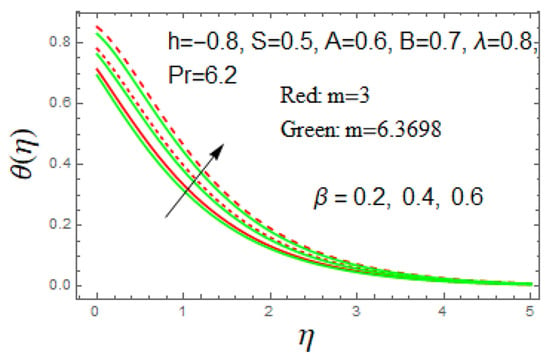
Figure 10.
Variations in temperature profile for different values of .
Table 3 shows the impact of different constraints on cylindrical and spherical shapes of the skin friction coefficient. It is noticed that with the increase in magnetic number , the slip parameter , stretching parameter and the wall mass transfer parameter , both the cylindrical and spherical shapes of the skin friction coefficient increase.

Table 3.
Numerical values of the local skin friction coefficient for various constraints when .
Table 4 represents the influence of various parameters on cylindrical and spherical shapes of the local Nusselt number. It shows that because of a raise in the Prandtl number , the cylindrical and spherical shapes of the Nusselt number are enhanced. Conversely, cylindrical and spherical shapes of the Nusselt number decline due to an increase in the slip parameter and heat generation parameter .

Table 4.
Numerical values of the local Nusselt number for different parameters when .
Table 5 and Figure 11 present the error analysis. The absolute error is decreasing with the increasing number of iterations.

Table 5.
Results of calculation for error analysis.

Figure 11.
Results of the calculation for error analysis.
Table 6 (Figure 12) and Table 7 (Figure 13) show the comparison of HAM and numerical solution for velocity and temperature profiles. An excellent agreement has been seen between analytical and numerical methods. The validity can be seen very clearly from these tables.

Table 6.
Comparison of HAM and the numerical solution for .
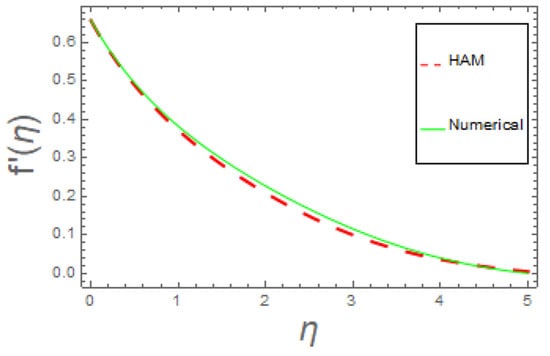
Figure 12.
Comparison graph of HAM and the numerical solution for .

Table 7.
Comparison of HAM and the numerical solution for .
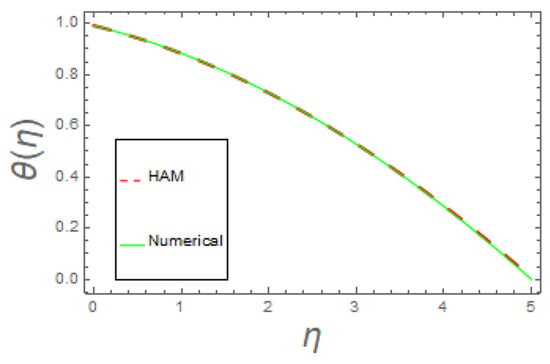
Figure 13.
Comparison graph of HAM and the numerical solution for .
5. Conclusions
Heat transfer of the magnetohydrodynamic hybrid nanofluid flow past an exponentially stretching surface with slip conditions in the presence of suction and injection has been investigated. The hybrid nanofluid of alumina and copper (hybrid nanoparticles) with blood (base fluid) has been considered. The homotopy analysis method (HAM) has been used to solve the stated problem analytically. The key points of the present article are given below.
- The rise in velocity slip and the magnetic parameters increases the skin friction. Consequently, it indicates a decline in the velocity of the fluid.
- The rise in the stretching/shrinking parameters decreases the skin friction. Therefore, it shows an increment in the velocity of the fluid.
- The Nusselt number is diminished with the increase in the thermal slip parameter and heat generation parameter.
- The temperature distribution rises with the enhancement of the heat generation parameter, while it decreases when the thermal slip parameter and mass transfer parameter rise.
- It is concluded from Table 4 that the heat transfer rate increases with raising , while it decreases with the enhancement of .
Author Contributions
Conceptualization, A.S.K.; Investigation, A.S.K.; Methodology, W.K.; Writing—review & editing, H.-Y.X. All authors have read and agreed to the published version of the manuscript.
Funding
This work was partially supported by the National Natural Science Foundation of China (Grant No. 11972306), and the 111 Project of China (Grant No. B17037).
Institutional Review Board Statement
Not applicable.
Informed Consent Statement
Not applicable.
Data Availability Statement
Not applicable.
Conflicts of Interest
The authors declare that there is no conflict of interest regarding the publication of this article.
References
- Maxwell, J.C. A Treatise on Electricity and Magnetism; Clarendon Press: Oxford, UK, 1873. [Google Scholar]
- Hamilton, R.L.; Crosser, O.K. Thermal Conductivity of Heterogeneous Two-Component Systems. Ind. Eng. Chem. Fundam. 1962, 1, 187–191. [Google Scholar] [CrossRef]
- Choi, S.U.S.; Eastman, J.A. Enhancing Thermal Conductivity of Fluids with Nanoparticles. ASME Fluids Eng. Div. 1995, 231, 99–106. [Google Scholar]
- Jana, S.; Salehi-Khojin, A.; Zhong, W.-H. Enhancement of fluid thermal conductivity by the addition of single and hybrid nano-additives. Thermochim. Acta 2007, 462, 45–55. [Google Scholar] [CrossRef]
- Jha, N.; Ramaprabhu, S. Thermal conductivity studies of metal dispersed multiwalled carbon nanotubes in water and ethylene glycol based nanofluids. J. Appl. Phys. 2009, 106, 084317. [Google Scholar] [CrossRef]
- Waini, I.; Ishak, A.; Pop, I. Hiemenz flow over a shrinking sheet in a hybrid nanofluid. Results Phys. 2020, 19, 103351. [Google Scholar] [CrossRef]
- Waini, I.; Ishak, A.; Pop, I. Hybrid nanofluid flow and heat transfer over a permeable biaxial stretching/shrinking sheet. Int. J. Numer. Methods Heat Fluid Flow 2019, 30, 3497–3513. [Google Scholar] [CrossRef]
- Waini, I.; Ishak, A.; Pop, I. Mixed convection flow over an exponentially stretching/shrinking vertical surface in a hybrid nanofluid. Alex. Eng. J. 2020, 59, 1881–1891. [Google Scholar] [CrossRef]
- Waini, I.; Ishak, A.; Pop, I. MHD flow and heat transfer of a hybrid nanofluid past a permeable stretching/shrinking wedge. Appl. Math. Mech. 2020, 41, 507–520. [Google Scholar] [CrossRef]
- Waini, I.; Ishak, A.; Pop, I. Hybrid nanofluid flow towards a stagnation point on an exponentially stretching/shrinking vertical sheet with buoyancy effects. Int. J. Numer. Methods Heat Fluid Flow 2021, 31, 216–235. [Google Scholar] [CrossRef]
- Li, H.; Ha, C.-S.; Kim, I. Fabrication of carbon nanotube/SiO2 and carbon nanotube/SiO2/Ag nanoparticles hybrids by using plasma treatment. Nanoscale Res. Lett. 2009, 4, 1384–1388. [Google Scholar] [CrossRef] [Green Version]
- Karthikeyan, N.; Philip, J.; Raj, B. Effect of clustering on the thermal conductivity of nanofluids. Mater. Chem. Phys. 2008, 109, 50–55. [Google Scholar] [CrossRef]
- Sastry, N.N.V.; Bhunia, A.; Sundararajan, T.; Das, S.K. Predicting the effective thermal conductivity of carbon nanotube based nanofluids. Nanotechnology 2008, 19, 055704. [Google Scholar] [CrossRef] [PubMed]
- Paul, G.; Philip, J.; Raj, B.; Das, P.K.; Manna, I. Synthesis, characterization, and thermal property measurement of nano-Al95Zn05 dispersed nanofluid prepared by a two-step process. Int. J. Heat Mass Transf. 2011, 54, 3783–3788. [Google Scholar] [CrossRef]
- Sidik, N.A.C.; Adamu, I.M.; Jamil, M.M. Preparation Methods and Thermal Performance of Hybrid Nanofluids. J. Adv. Res. Appl. Mech. 2020, 66, 7–16. [Google Scholar] [CrossRef]
- Choi, S.U.S.; Zhang, Z.G.; Yu, W.; Lockwood, F.E.; Grulke, E.A. Anomalous thermal conductivity enhancement in nanotube suspensions. Appl. Phys. Lett. 2001, 79, 2252–2254. [Google Scholar] [CrossRef]
- Nor Azwadi, C.S.; Adamu, I. Turbulent force convective heat transfer of hybrid nano fluid in a circular channel with constant heat flux. J. Adv. Res. Fluid Mech. Therm. Sci. 2016, 19, 1–9. [Google Scholar]
- Eastman, J.A.; Choi, S.U.-S.; Li, S.; Yu, W.; Thompson, L.J. Anomalously increased effective thermal conductivities of ethylene glycol-based nanofluids containing copper nanoparticles. Appl. Phys. Lett. 2001, 78, 718–720. [Google Scholar] [CrossRef]
- Xuan, Y.; Li, Q. Investigation on Convective Heat Transfer and Flow Features of Nanofluids. J. Heat Transf. 2003, 125, 151–155. [Google Scholar] [CrossRef] [Green Version]
- Li, D.; Hong, B.; Fang, W.; Guo, Y.; Lin, R. Preparation of Well-Dispersed Silver Nanoparticles for Oil-Based Nanofluids. Ind. Eng. Chem. Res. 2010, 49, 1697–1702. [Google Scholar] [CrossRef]
- Lee, Y.K. The use of nanofluids in domestic water heat exchanger. J. Adv. Res. Appl. Mech. 2014, 3, 9–24. [Google Scholar]
- Park, S.D.; Lee, S.W.; Kang, S.; Bang, I.C.; Kim, J.H.; Shin, H.S.; Lee, D.W. Effects of nanofluids containing graphene/graphene-oxide nanosheets on critical heat flux. Appl. Phys. Lett. 2010, 97, 023103. [Google Scholar] [CrossRef] [Green Version]
- Kang, S.W.; Wei, W.-C.; Tsai, S.-H.; Yang, S.-Y. Experimental investigation of silver nano-fluid on heat pipe thermal performance. Appl. Therm. Eng. 2006, 26, 2377–2382. [Google Scholar] [CrossRef]
- Abubakar, S.; Nor Azwadi, C.S.; Ahmad, A. The use of Fe3O4-H2O4 nanofluid for heat transfer enhancement in rectangular microchannel Heatsink. J. Adv. Res. Mater. Sci. 2016, 23, 15–24. [Google Scholar]
- Yashkun, U.; Zaimi, K.; Abu Bakar, N.A.; Ishak, A.; Pop, I. MHD hybrid nanofluid flow over a permeable stretching/shrinking sheet with thermal radiation effect. Int. J. Numer. Methods Heat Fluid Flow 2021, 31, 1014–1031. [Google Scholar] [CrossRef]
- Lund, L.A.; Omar, Z.; Khan, I.; Seikh, A.H.; Sherif, E.-S.M.; Nisar, K.S. Stability analysis and multiple solution of Cu–Al2O3/H2O nanofluid contains hybrid nanomaterials over a shrinking surface in the presence of viscous dissipation. J. Mater. Res. Technol. 2020, 9, 421–432. [Google Scholar] [CrossRef]
- Lund, L.A.; Omar, Z.; Khan, I.; Sherif, E.-S.M. Dual Solutions and Stability Analysis of a Hybrid Nanofluid over a Stretching/Shrinking Sheet Executing MHD Flow. Symmetry 2020, 12, 276. [Google Scholar] [CrossRef] [Green Version]
- Aladdin, N.A.L.; Bachok, N.; Pop, I. Cu-Al2O3/Water Hybrid Nanofluid Flow over a Permeable Moving Surface in Presence of Hydromagnetic and Suction Effects. Alex. Eng. J. 2020, 59, 657–666. [Google Scholar] [CrossRef]
- Roşca, N.C.; Roşca, A.V.; Jafarimoghaddam, A.; Pop, I. Cross flow and heat transfer past a permeable stretching/shrinking sheet in a hybrid nanofluid. Int. J. Numer. Methods Heat Fluid Flow 2021, 31, 1295–1319. [Google Scholar] [CrossRef]
- Khashi’Ie, N.S.; Arifin, N.M.; Pop, I.; Nazar, R. Melting heat transfer in hybrid nanofluid flow along a moving surface. J. Therm. Anal. Calorim. 2020, 1–12. [Google Scholar] [CrossRef]
- Khashi’Ie, N.S.; Arifin, N.M.; Pop, I.; Nazar, R.; Hafidzuddin, E.H.; Wahi, N. Flow and heat transfer past a permeable power-law deformable plate with orthogonal shear in a hybrid nanofluid. Alex. Eng. J. 2020, 59, 1869–1879. [Google Scholar] [CrossRef]
- Khashi’Ie, N.S.; Arifin, N.M.; Pop, I.; Wahid, N.S. Flow and heat transfer of hybrid nanofluid over a permeable shrinking cylinder with Joule heating: A comparative analysis. Alex. Eng. J. 2020, 59, 1787–1798. [Google Scholar] [CrossRef]
- Khashi’ie, N.S.; Md Arifin, N.; Pop, I. Mixed Convective Stagnation Point Flow towards a Vertical Riga Plate in Hybrid Cu-Al2O3/Water Nanofluid. Mathematics 2020, 8, 912. [Google Scholar] [CrossRef]
- Roy, N.C.; Pop, I. Flow and heat transfer of a second-grade hybrid nanofluid over a permeable stretching/shrinking sheet. Eur. Phys. J. Plus 2020, 135, 1–19. [Google Scholar] [CrossRef]
- Zainal, N.A.; Nazar, R.; Naganthran, K.; Pop, I. MHD flow and heat transfer of hybrid nanofluid over a permeable moving surface in the presence of thermal radiation. Int. J. Numer. Methods Heat Fluid Flow 2021, 31, 858–879. [Google Scholar] [CrossRef]
- Anuar, N.S.; Bachok, N.; Pop, I. Radiative hybrid nanofluid flow past a rotating permeable stretching/shrinking sheet. Int. J. Numer. Methods Heat Fluid Flow 2021, 31, 914–932. [Google Scholar] [CrossRef]
- Gangadhar, K.; Bhargavi, D.N.; Kannan, T.; Rao, M.V.S.; Chamkha, A.J. Transverse MHD flow of Al2O3-Cu/H2O hybrid nanofluid with active radiation: A novel hybrid model. Math. Methods Appl. Sci. 2020, 1–19. [Google Scholar] [CrossRef]
- Wahid, N.S.; Md Arifin, N.; Turkyilmazoglu, M.; Hafidzuddin, M.E.H.; Abd Rahmin, N.A. MHD Hybrid Cu-Al2O3/Water Nanofluid Flow with Thermal Radiation and Partial Slip Past a Permeable Stretching Surface: Analytical Solution. J. Nano Res. 2020, 64, 75–91. [Google Scholar] [CrossRef]
- Khadija, M.; Naeema, M.; Rahmat, I.; Sadiq, M.S. Influence of heat transfer on MHD Carreau fluid flow due to motile cilia in a channel. J. Therm. Anal. Calorim. 2021, 144, 2317–2326. [Google Scholar]
- Rajesh, V.; Sheremet, M.A.; Hakan, F.O. Impact of hybrid nanofluids on MHD flow and heat transfer near a vertical plate with ramped wall temperature. Case Stud. Therm. Eng. 2021, 28, 101557. [Google Scholar] [CrossRef]
- Othman, M.N.; Jedi, A.; Abu Bakar, N.A. MHD Flow and Heat Transfer of Hybrid Nanofluid over an Exponentially Shrinking Surface with Heat Source/Sink. Appl. Sci. 2021, 11, 8199. [Google Scholar] [CrossRef]
- Murugesan, T.; Kumar, M.D. Effects of Thermal Radiation and Heat Generation on Hydromagnetic Flow of Nanofluid over an Exponentially Stretching Sheet in a Porous Medium with Viscous Dissipation. World Sci. News 2019, 128, 130–147. [Google Scholar]
- Ghosh, S.; Mukhopadhyay, S. Stability analysis for model-based study of nanofluid flow over an exponentially shrinking permeable sheet in presence of slip. Neural Comput. Appl. 2020, 32, 7201–7211. [Google Scholar] [CrossRef]
- Tayebi, T.; Chamkha, A.J. Entropy generation analysis during MHD natural convection flow of hybrid nanofluid in a square cavity containing a corrugated conducting block. Int. J. Numer. Methods Heat Fluid Flow 2019, 30, 1115–1136. [Google Scholar] [CrossRef]
- Takabi, B.; Salehi, S. Augmentation of the Heat Transfer Performance of a Sinusoidal Corrugated Enclosure by Employing Hybrid Nanofluid. Adv. Mech. Eng. 2014, 6, 147059. [Google Scholar] [CrossRef]
- Oztop, H.F.; Abu-Nada, E. Numerical study of natural convection in partially heated rectangular enclosures filled with nanofluids. Int. J. Heat Fluid Flow 2008, 29, 1326–1336. [Google Scholar] [CrossRef]
- Waini, I.; Ishak, A.; Pop, I. Hybrid nanofluid flow induced by an exponentially shrinking sheet. Chin. J. Phys. 2020, 68, 468–482. [Google Scholar] [CrossRef]
- Liao, S.L. The Proposed Homotopy Analysis Technique for the Solution of Nonlinear Problems. Ph.D. Thesis, Shanghai Jiao Tong University, Shanghai, China, 1992. [Google Scholar]
- Liao, S. An optimal homotopy-analysis approach for strongly nonlinear differential equations. Commun. Nonlinear Sci. Numer. Simul. 2010, 15, 2003–2016. [Google Scholar] [CrossRef]
Publisher’s Note: MDPI stays neutral with regard to jurisdictional claims in published maps and institutional affiliations. |
© 2021 by the authors. Licensee MDPI, Basel, Switzerland. This article is an open access article distributed under the terms and conditions of the Creative Commons Attribution (CC BY) license (https://creativecommons.org/licenses/by/4.0/).